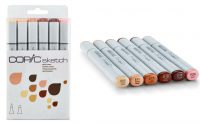Traditional painting brushes – which one should you use?
Each of the painting techniques requires the selection of the right tool – in this case a brush. The type of bristles from which they are made is of the greatest importance in the selection of brushes. The shape and size is selected individually, depending on the specific work and preferences of the painter. Paintbrushes have a long history, some are made from animal hair, however, lately more and more popular are becoming brushes made of synthetics materials. In this article not only you will find out which brush is the best for oil or acrylic painting, but also what is a painting brush made of.
Shape
Professional art brushes can be divided due to the shape of the tip, as well as the type and softness of the bristles and the material from which it is made.
The brush tip has different shapes: round, flat, oval, angular, or filberts.
Round brushes, the bristles of which are tied round and fastened with a ring or additionally twisted with a string are useful especially for coating the outer parts of windows and wooden structures, surfaces with uneven, convex construction, chemical coatings and applying anti-corrosion paints.
Flat and English brushes are best suited for painting larger surfaces. They are used for fast-drying and well-spreading varnishes and for the distribution of water-based paints and dispersion varnishes. There are used handles made of raw, varnished and plastic wood.
Oval brushes combine the advantages of round and flat brushes, fastened in a metal ferrule with a lacquered or plastic handle.
Angular brushes are designed for painting corners and edges, tight and hard to reach places, most often with a handle made of raw wood.
Brushes are used for painting on large flat surfaces with all kinds of water paints (glue, emulsion, acrylic, etc.). They are also necessary for priming walls, washing paint, applying glue for wallpaper.
They are produced in various sizes (in inch and millimeter numbering) defining the width or diameter of the brush.
Brush shape and its usage table
Name / Shape |
Description |
Usage |
Type of paint |
Bristle |
| Round | ferrule, round or pointed tip. Available in many sizes, lengths and types. | Details, fillings, retouching and finishing. Thin, suitable for graphic works | All types of paints, especially recommended for oil and acrylic painting | Every type of natural bristles and synthetic bristles |
Pointed-Round |
Narrower than the standard round brush. Round ferrule, sharp tip | Details and finishing, delicate workmanship. Spotting and retouching. | All types of paints, especially recommended for tempera and watercolor painting as well as for modeling and decorating, | sable, synthetic |
Flat |
Flat ferrule, square tip. Very good ability to absorb color, it is easy to maneuver. | Drawing, retouching, good for dilute colors. Creates bold, radical strokes. | All types of paints. | sable, badger, Swine bristles, synthetic |
Bright |
Flat ferrule, internally curved edge at the tip. Long handle | Suitable for creating details, thick lines. Short, controlled strokes, for glazing | Oil and acrylic paints, Decorative |
sable, badger, Swine bristles, synthetic |
Filbert |
It combines the features of a flat and round brush, called a hazelnut brush or a hazelnut shape | Retouching and finishing. Delicate performance, suitable for mixing. | Oil and acrylic paints, Decorative | sable, badger, Swine bristles, synthetic |
| Egbert | Flat ferrule, rounded tip, long elastic bristles for better paint storage capacity, long handle. | Delicate rounded tip suitable for mixing paints and graphic works. | Oil and acrylic paints, Decorative | Badger |
| Fan
|
Flat ferrule, spread bristles. Depending on the purpose, natural bristles are more delicate and suitable for mixing adjacent color patches, while synthetic ones are good for giving different textures.
|
For mottled effects, creating shades, glazing and transmit different textures
|
Oil and acrylic paints.
Decorative. Tempera and watercolor.
|
badger,
synthetic
|
| Liner | A narrow brush with very long bristles. Very high ink retention capacity | For accurate and fast work, writing and underlining | Watercolor paints,
decorative, Ink |
sable,
synthetic Ox / Buffalo |
| “Cats Tounge” | A flat ferrule, shorter bristles than other round brushes with a pointed tip but well holding the paint, short handle. | Suitable for painting details, short strokes | Watercolor, oil, tempera and ink | sable |
| Oblique | Diagonally cut bristles, flat ferrule, long handle | Drawing, retouching, creating backgrounds in images | Oil paint,
Acrylic paints |
Bristles,
synthetic sable |
| Wide brushes for wash painting
|
Wide brushes with short handles. Depending on the shape, they are suitable for overcoating very large areas, synthetic fibers hold paint well, are ideally suited for wash painting and controlling paint flow. | wash painting, varnishing, diluting the color | varnishes,
Oil paints, Temper Paints, Watercolor paints (depending on the specific shape) |
Bristles,
Synthetic, Sable |
Size
The size of a brush is indicated by a number printed on the handle. Brushes start from 000, then 00, 0, 1, 2, and up. The higher the number, the bigger or wider the brush. But be careful while purchasing a brush, there is little consistency between brush manufacturers as to what these sizes actually are, so a number 10 in one brand can be a different size to a number 10 in another brand.
What is paint brush made of?
Since you already know what brush shape you need, it’s time to familiarize yourself with what characterizes the brush-bristle.
The bristles may be made from natural, synthetic fibers, or a blend of these fibers. Here, stick to the general rule – you will use natural fiber bristles for solvent-based inks, and synthetic fiber bristles for waterborne paints. This is due to the fact that natural fibers absorb water, and therefore they swell, so they are not used for paints in which the solvent is water, e.g. in acrylic paints.
Remember also that the fibers from which the brush bristles are made can be a mixture of synthetic and natural fibers. However, it should not discourage you, just choose a brush with the predominance of these fibers you need.
How to clean a paint brush
Before washing, use the entire paint content remaining on the brush. If necessary, use a cleaning cloth to rub all paint on the brush. Only after maximum emptying of the bristles from the paint, proceed to wash. Here you have to remember about one and only principle. Use as solvent exactly what is the solvent for the paint used. For acrylic and other waterborne paints, the brush will simply be washed in clean water. For oil-and-phthalic paints, use an oil-phthalic solvent, etc. The same applies if you want to soak the brush and leave it in the container with the liquid before next use. Remember to use the solvent you used for washing.



